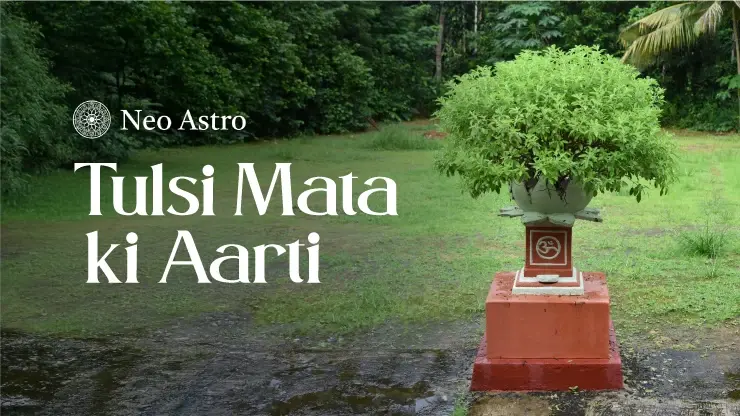Tulsi Mata Ki Aarti in Hindi (तुलसी माता की आरती)

तुलसी जी की आरती — हिंदी में
जय जय तुलसी माता, मैय्या जय तुलसी माता।
सब जग की सुख दाता, सबकी वर माता॥
मैय्या जय तुलसी माता॥
सब योगों से ऊपर, सब रोगों से ऊपर।
रज से रक्ष कर के, सबकी भव त्राता॥
मैय्या जय तुलसी माता॥
बहु पुत्री है श्यामा, सूर बल्ली है ग्राम्या।
विष्णुप्रिय जो नर तुमको सेवे, सो नर तर जाता॥
मैय्या जय तुलसी माता॥
हरि के शीश विराजत, त्रिभुवन से हो वंदित।
पतित जनों की तारिणी, तुम हो विख्याता॥
मैय्या जय तुलसी माता॥
लेकर जन्म विजन में, आई दिव्य भवन में।
मानव लोक तुमहीं से, सुख संपति पाता॥
मैय्या जय तुलसी माता॥
हरि को तुम अति प्यारी, श्याम वर्ण सुकुमारी।
प्रेम अजब है उनका, तुमसे कैसा नाता।
हमारी विपद हरो तुम, कृपा करो माता॥
जय जय तुलसी माता, मैय्या जय तुलसी माता।
सब जग की सुख दाता, सबकी वर माता॥
मैय्या जय तुलसी माता॥
Tulsi Mata Ki Aarti - English
Jai Jai Tulsi Mata, Maiyya Jai Tulsi Mata.
Sab Jag Ki Sukh Daata, Sabki Var Mata.
Maiyya Jai Tulsi Mata.
Sab Yogon Se Upar, Sab Rogon Se Upar.
Raj Se Raksh Kar Ke, Sabki Bhav Traata.
Maiyya Jai Tulsi Mata.
Bahu Putri Hai Shyama, Soor Balli Hai Gramya.
Vishnu Priya Jo Nar Tumko Seve, So Nar Tar Jaata.
Maiyya Jai Tulsi Mata.
Hari Ke Sheesh Virajat, Tribhuvan Se Ho Vandit.
Patit Janon Ki Tarini, Tum Ho Vikhyata.
Maiyya Jai Tulsi Mata.
Lekar Janm Vijan Mein, Aayi Divya Bhavan Mein.
Manav Lok Tumhi Se, Sukh Sampati Paata.
Maiyya Jai Tulsi Mata.
Hari Ko Tum Ati Pyari, Shyam Varn Sukumari.
Prem Ajab Hai Unka, Tumse Kaisa Naata.
Hamari Vipad Haro Tum, Kripa Karo Mata.
Jai Jai Tulsi Mata, Maiyya Jai Tulsi Mata.
Sab Jag Ki Sukh Daata, Sabki Var Mata.
Maiyya Jai Tulsi Mata.
तुलसी जी की आरती का अर्थ (Meaning of the Aarti in Hindi)
इस आरती में भक्त अत्यंत श्रद्धा और भक्ति भाव से तुलसी माता की स्तुति करते हैं, जो भगवान विष्णु की प्रिय पत्नी वृंदा देवी का प्रतीक मानी जाती हैं। तुलसी माता का स्थान हिंदू धर्म में अत्यंत पवित्र और पूजनीय है, क्योंकि वे न केवल भक्ति, पवित्रता और समर्पण का प्रतीक हैं, बल्कि जीवन में सुख, समृद्धि और शांति प्रदान करने वाली देवी भी हैं।
पहली पंक्ति में तुलसी माता को समस्त जगत की सुखदायिनी और वरदायिनी कहा गया है; अर्थात् वे सम्पूर्ण संसार को आनंद, सुख और आशीर्वाद प्रदान करती हैं। भक्त यह स्वीकार करते हैं कि माता का आशीर्वाद ही जीवन में सच्चे आनंद और संतोष का कारण है।
दूसरी पंक्ति में यह भाव व्यक्त किया गया है कि तुलसी माता सभी युगों और सभी रोगों से परे हैं। उनका दिव्य स्वरूप सांसारिक दुख, रोग और कष्टों से मुक्त है, और वे अपने भक्तों की रक्षा कर उन्हें आध्यात्मिक बल प्रदान करती हैं।
तीसरी पंक्ति में यह कहा गया है कि जो भी भक्त तुलसी माता की सच्चे मन से सेवा करता है, वह भगवान विष्णु का प्रिय बन जाता है और मोक्ष, अर्थात् जन्म-मृत्यु के चक्र से मुक्ति प्राप्त करता है। यह सेवा केवल बाहरी पूजा नहीं, बल्कि आंतरिक भक्ति और पवित्रता का प्रतीक है।
चौथी पंक्ति में तुलसी माता को तीनों लोकों स्वर्ग, पृथ्वी और पाताल की वंदनीय देवी बताया गया है। वे पतित जनों की तारिणी हैं, अर्थात् जो लोग पाप या भ्रम में पड़े हैं, उन्हें सही मार्ग दिखाकर उद्धार करती हैं।
पांचवीं पंक्ति में तुलसी माता के जन्म का उल्लेख करते हुए यह कहा गया है कि उन्होंने मानव लोक के कल्याण के लिए अवतार लिया। उनके कारण ही मनुष्यों को जीवन में सुख, समृद्धि और शुभ फल प्राप्त होते हैं। तुलसी का पौधा घर में शुद्धता, सौभाग्य और सकारात्मकता का स्रोत माना जाता है।
अंत में, छठी पंक्ति में तुलसी माता के भगवान हरि (विष्णु) से अनन्य प्रेम का वर्णन किया गया है। यह दिव्य प्रेम भक्त और भगवान के बीच के शुद्ध संबंध का प्रतीक है। इस पंक्ति में भक्तजन तुलसी माता से विनती करते हैं कि वे उन पर कृपा करें, उनके जीवन से सभी विपदाएं दूर करें और उन्हें अपने स्नेह और आशीर्वाद से सदैव सुरक्षित रखें।
इस प्रकार, पूरी आरती भक्त को न केवल धार्मिक आस्था से जोड़ती है, बल्कि उसे जीवन के हर पहलू में भक्ति, पवित्रता और कृतज्ञता की भावना से ओतप्रोत करती है।
Spiritual Significance of Tulsi Mata Ki Aarti
The Tulsi Mata Aarti is a devotional hymn that symbolises purity, faith, and the divine connection between humans and nature. Performing this aarti is not merely a ritual; it is an act of spiritual awakening and gratitude.
1. Symbol of Devotion and Purity
Tulsi is revered as the earthly form of Vrinda Devi, the consort of Lord Vishnu. By performing her aarti, devotees express their surrender, humility, and devotion. Lighting the lamp before Tulsi represents illuminating one’s inner self, dispelling ignorance, and inviting spiritual clarity.
2. Connection to Lord Vishnu
The aarti lyrics celebrate Tulsi as “Hari ke sheesh virajat”, meaning she rests upon Lord Vishnu’s head. This highlights her sacred status and divine bond with Vishnu, making her worship integral to Vaishnav traditions.
3. Ecological and Spiritual Harmony
Beyond its spiritual essence, Tulsi also embodies environmental consciousness. Keeping a Tulsi plant purifies air and symbolises the coexistence of nature and divinity — reminding us that caring for nature is also an act of worship.
4. Emotional and Mental Upliftment
Chanting the Tulsi Ji Ki Aarti creates a peaceful vibration that calms the mind and uplifts the heart. It encourages mindfulness and connects the devotee to the rhythm of daily prayer and gratitude.
Benefits of Tulsi Mata Aarti
Performing this sacred aarti offers numerous spiritual and practical benefits. Some of the must-know benefits of Reciting Tulsi Mata Ki Aarti are listed below:
Brings peace and prosperity to the household.
Purifies the home atmosphere and dispels negative energy.
Promotes health and well-being, symbolically protecting from diseases.
Increases devotion and focus towards Lord Vishnu.
Removes obstacles and grants fulfilment of wishes.
Encourages environmental awareness and reverence for nature.
Best Timings
- Morning (Brahma Muhurta): Ideal time to offer fresh devotion and purity to the day.
- Evening (Sunset): To express gratitude and seek protection for the night.
- Special Days: During Kartik Maas and Tulsi Vivah, the aarti holds exceptional significance and should be performed with full devotion.
How to Perform
- Clean the area around the Tulsi plant.
- Light a diya (lamp) filled with ghee or oil.
- Offer flowers, water, and incense.
- Recite the aarti slowly and reverently, focusing on its meaning.
- End with Tulsi Pradakshina (circumambulation) and offer your prayers.
Frequently Asked Questions - Tulsi Mata Aarti
Who can perform Tulsi Mata Ki Aarti?

Anyone with a pure heart and sincere devotion can perform the aarti — men, women, or children alike. What matters most is faith and respect, not complex rituals.
What is the ideal time for Tulsi Mata Aarti?

The best times are early morning at sunrise and in the evening at dusk. These transition periods are believed to carry divine energy and purity.
What does the Tulsi Mata Aarti symbolise?

It represents the triumph of purity, devotion, and light over darkness, ignorance, and negativity, reminding devotees of spiritual awakening.
Is Tulsi Mata Aarti linked to Lord Vishnu?

Yes, Tulsi is considered the beloved of Lord Vishnu. Performing her aarti is believed to please the Lord and attract divine blessings and grace.
What are the health or environmental benefits?

Tulsi naturally purifies the air, reduces stress, and enhances mental peace. Spiritually, it symbolises cleansing of the soul and removal of negative energy.
On which festival is this aarti most significant?

The aarti holds special importance during Tulsi Vivah, the divine wedding of Tulsi and Lord Vishnu, celebrated in Kartik Maas with great devotion.
